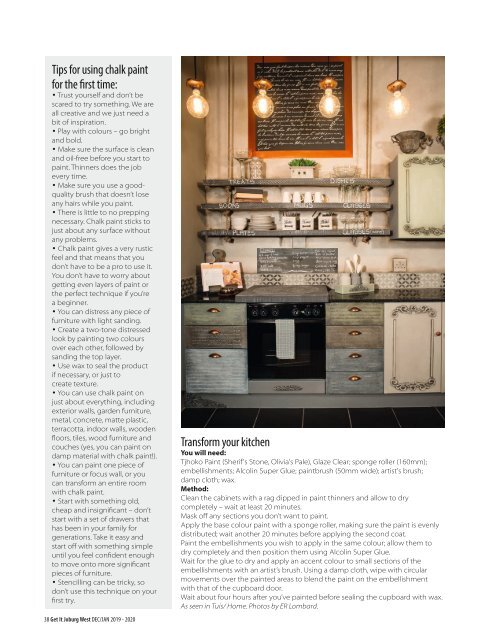You also want an ePaper? Increase the reach of your titles
YUMPU automatically turns print PDFs into web optimized ePapers that Google loves.
Tips for using chalk paint<br />
for the first time:<br />
• Trust yourself and don’t be<br />
scared to try something. We are<br />
all creative and we just need a<br />
bit of inspiration.<br />
• Play with colours – go bright<br />
and bold.<br />
• Make sure the surface is clean<br />
and oil-free before you start to<br />
paint. Thinners does the job<br />
every time.<br />
• Make sure you use a goodquality<br />
brush that doesn’t lose<br />
any hairs while you paint.<br />
• There is little to no prepping<br />
necessary. Chalk paint sticks to<br />
just about any surface without<br />
any problems.<br />
• Chalk paint gives a very rustic<br />
feel and that means that you<br />
don’t have to be a pro to use it.<br />
You don’t have to worry about<br />
getting even layers of paint or<br />
the perfect technique if you’re<br />
a beginner.<br />
• You can distress any piece of<br />
furniture with light sanding.<br />
• Create a two-tone distressed<br />
look by painting two colours<br />
over each other, followed by<br />
sanding the top layer.<br />
• Use wax to seal the product<br />
if necessary, or just to<br />
create texture.<br />
• You can use chalk paint on<br />
just about everything, including<br />
exterior walls, garden furniture,<br />
metal, concrete, matte plastic,<br />
terracotta, indoor walls, wooden<br />
floors, tiles, wood furniture and<br />
couches (yes, you can paint on<br />
damp material with chalk paint!).<br />
• You can paint one piece of<br />
furniture or focus wall, or you<br />
can transform an entire room<br />
with chalk paint.<br />
• Start with something old,<br />
cheap and insignificant – don’t<br />
start with a set of drawers that<br />
has been in your family for<br />
generations. Take it easy and<br />
start off with something simple<br />
until you feel confident enough<br />
to move onto more significant<br />
pieces of furniture.<br />
• Stencilling can be tricky, so<br />
don’t use this technique on your<br />
first try.<br />
38 Get It Joburg <strong>West</strong> DEC/JAN <strong>2019</strong> - <strong>2020</strong><br />
Transform your kitchen<br />
You will need:<br />
Tjhoko Paint (Sherif's Stone, Olivia's Pale), Glaze Clear; sponge roller (160mm);<br />
embellishments; Alcolin Super Glue; paintbrush (50mm wide); artist's brush;<br />
damp cloth; wax.<br />
Method:<br />
Clean the cabinets with a rag dipped in paint thinners and allow to dry<br />
completely – wait at least 20 minutes.<br />
Mask off any sections you don’t want to paint.<br />
Apply the base colour paint with a sponge roller, making sure the paint is evenly<br />
distributed; wait another 20 minutes before applying the second coat.<br />
Paint the embellishments you wish to apply in the same colour; allow them to<br />
dry completely and then position them using Alcolin Super Glue.<br />
Wait for the glue to dry and apply an accent colour to small sections of the<br />
embellishments with an artist’s brush. Using a damp cloth, wipe with circular<br />
movements over the painted areas to blend the paint on the embellishment<br />
with that of the cupboard door.<br />
Wait about four hours after you’ve painted before sealing the cupboard with wax.<br />
As seen in Tuis/ Home. Photos by ER Lombard.


















